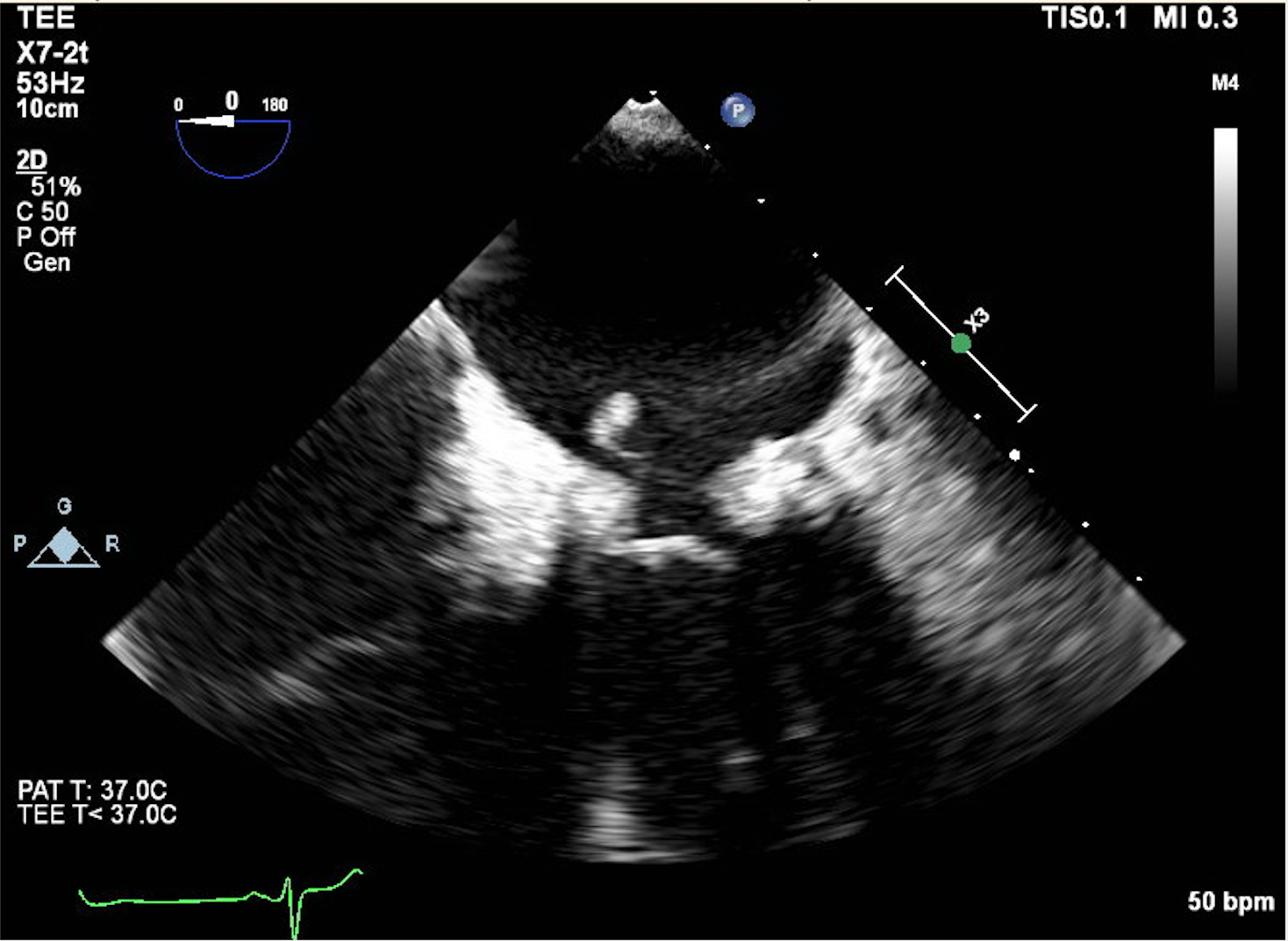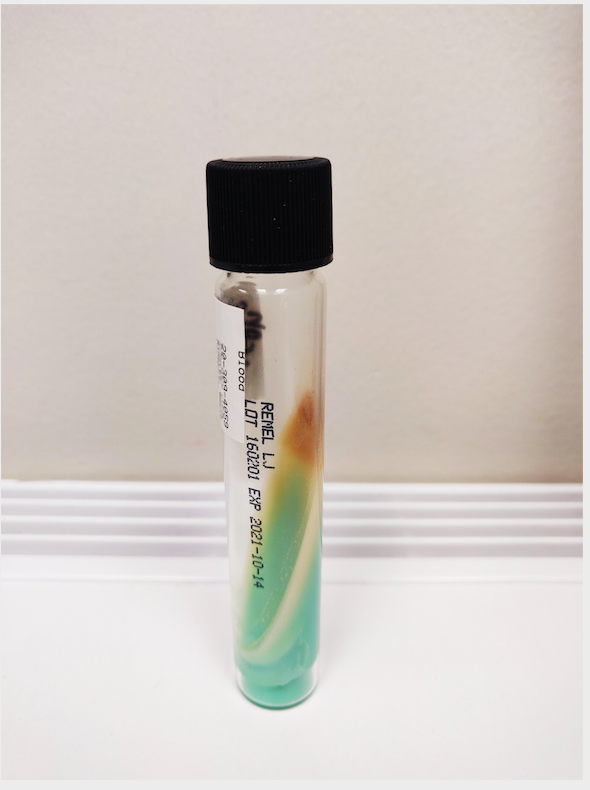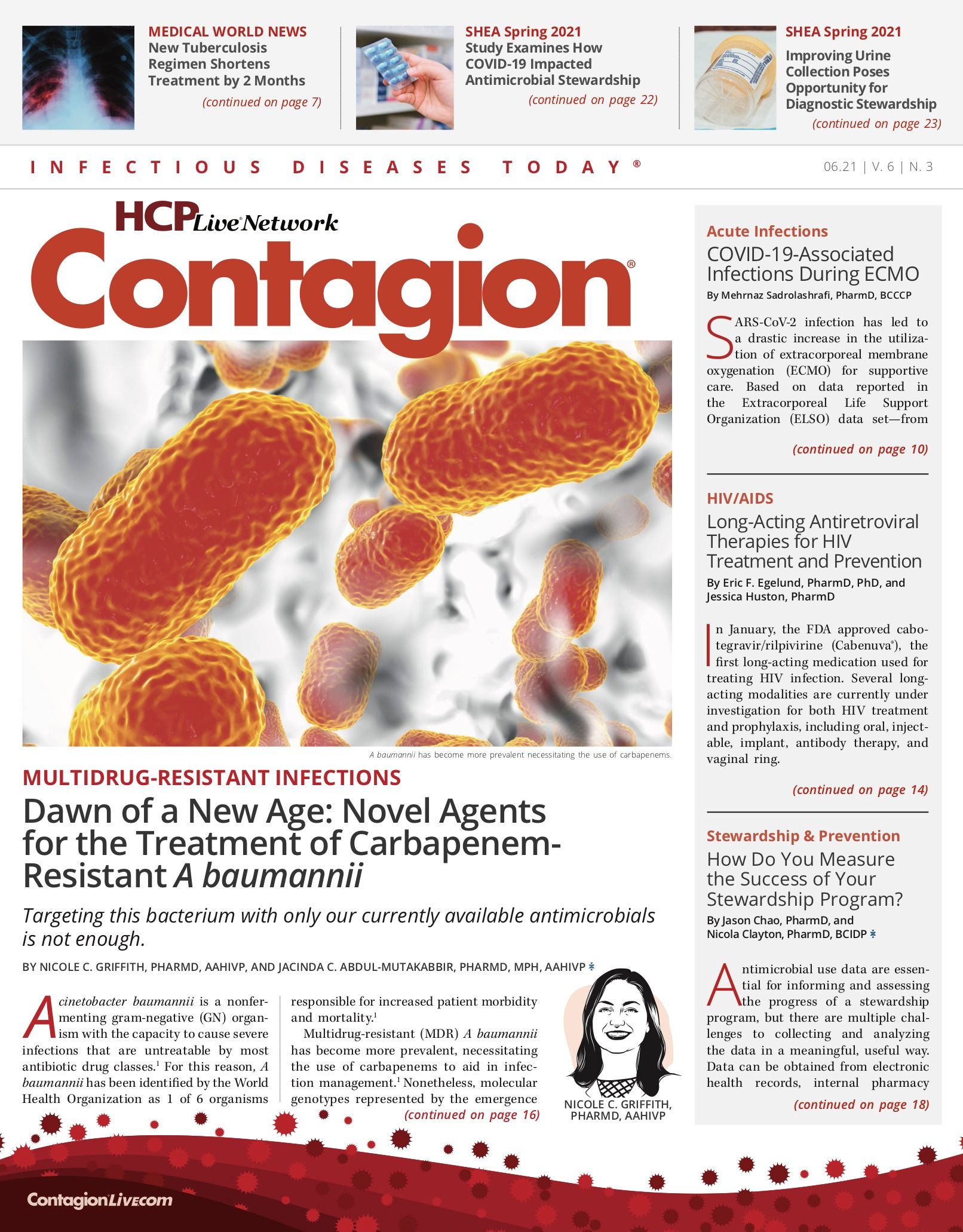A Case of Mycobacterium Chimaera Infective Endocarditis
Nonspecific, nondolent symptoms make this disease difficult to diagnose.
Final Diagnosis: Mycobacterium Chimaera Infective Endocarditis
History of Present Illness
A 55-year-old male presented to our emergency department at the behest of his primary care physician after being evaluated for dysarthria and left upper-extremity weakness, which had been present for the past month. His symptoms were sudden in onset. His left upper-extremity weakness had gradually resolved over the past few weeks, but he continued to have mild dysarthria.
Past Medical History
The patient had a history of hypertension and mitral valve prolapse. Five years prior, he underwent a percutaneous balloon mitral valvuloplasty, followed by placement of an annuloplasty ring and a left atrial appendage clip.
Key Medications
None
Epidemiological History
The patient was born in New York, raised in Pittsburgh, Pennsylvania, and has lived in Philadelphia for the past 25 years. He is divorced and lives alone. He does not have pets. He works as a health advocate. He said he did not travel outside of the country. He hikes occasionally but said he had no any animal contact. He is not sexually active. He smokes cigarettes daily and drinks beer occasionally. He claimed no intravenous drug use.
Physical Examination
On presentation, the patient was afebrile, and vitals were within normal limits. He was noted to have mild slurring of speech and a broken, decayed molar tooth. There were no stigmata of infective endocarditis. The rest of his exam was without obvious abnormalities.
Figure 1.

Studies
Initial lab work showed no leukocytosis or renal/hepatic derangements. Blood cultures were sent and yielded no growth. An MRI showed acute ischemia in the midbrain with small chronic infarctions in the right thalamus and bilateral cerebellar hemispheres. A transesophageal echocardiogram Figure 1 showed 2 large, mobile echo-densities attached to the mitral valve, emanating from the annuloplasty ring.
Clinical Course
The patient underwent bioprosthetic mitral valve replacement and explantation of the annuloplasty ring. Mitral valvular tissue was sent for surgical pathology along with acid-fast bacilli, fungal, and tissue cultures. In addition, a paraffin block of mitral valve tissue was sent to an outside laboratory for 16S ribosomal RNA (rRNA) sequencing. Surgical pathology showed variably intense acute and chronic inflammation suggestive of infective endocarditis. Serial blood cultures were negative throughout the hospital stay and all surgical cultures yielded no growth. Bartonella/Coxiella burnetii species serologies were negative. 16S rRNA sequencing did not identify the culprit organism. The patient was discharged on ceftriaxone, doxycycline, and vancomycin. He was doing well on his outpatient follow-up visit after completing 6 weeks of antibiotic therapy.
The patient presented 1 year later with fevers, fatigue, dyspnea, and dry cough that had been present for 2 weeks. A CT scan of the chest showed diffuse, patchy ground-glass opacities and an 8-millimeter left lung apical nodule suspicious for malignancy. COVID-19 testing was negative. Lab work showed a white blood cell count of 4300/µL (normal range, 4-11×103/µL), platelet count of 42000/µL (normal range, 140-450×103 /µL), hemoglobin level of 9.4 g/dL (normal range, 14-18 g/dL), lactate dehydrogenase level of 1179 IU/L (normal range, 125-220 IU/L), ferritin level of 9335 ng/mL (normal range, 22-275 ng/mL), and a fibrinogen level of 73 mg/dL (normal range, 200-600 mg/dL). A transthoracic echocardiogram showed a mobile echo-density on the anterior mitral leaflet. Blood cultures were negative throughout the admission. A bone marrow biopsy was performed due to suspicion of hemophagocytic lymphohistiocytosis (HLH) and showed macrophages engulfing nucleated red cells and myeloid cells, confirming the diagnosis. Special bone marrow stains for acid-fast bacilli and fungi were negative. In light of the HLH, the patient was deemed high risk for bleeding during valvular surgery and managed with medical therapy alone. He was subsequently discharged with doxycycline for 6 weeks and a corticosteroid taper for management of the HLH.
Diagnostic Procedures and Results
An outpatient PET scan 1 month later again showed an apical nodule on the left lung suspicious for malignancy. Three weeks after the PET scan, the patient returned to the emergency department for fevers, chills, and drenching sweats. A transesophageal echocardiogram revealed a mobile echo-density (1.5 cm×0.9 cm large) on the anterior mitral leaflet and severe prosthetic mitral valve stenosis. Blood cultures were once again negative. Interventional radiology performed a core biopsy of the lung nodule, and the patient was diagnosed with a large cell neuroendocrine tumor. A blood sample was sent to an outside laboratory for Karius cell-free DNA sequencing, which returned positive for Mycobacterium chimaera. Acid-fast bacilli blood cultures were collected, which were positive for acid-fast bacilli at 4 weeks and for Mycobacterium avium complex at 8 weeks.
Treatment and Follow-up
The patient was started on azithromycin, ethambutol, rifabutin, and intravenous amikacin. He was deemed a poor candidate for repeat valve surgery due to his underlying comorbidities, started on radiation therapy for his neuroendocrine tumor, and discharged home. He returned to the hospital 2 weeks later with acute kidney injury secondary to aminoglycoside toxicity. Discussions with the patient and his family resulted in him being eventually discharged to home hospice.
Discussion
M chimaera is a member of the nontuberculous mycobacteria group found ubiquitously in nature. First described in 2004 by Tortoli et al,1 it is genetically related to the MAIS group (M avium, M intracellulare, and M scrofulaceum) but different from all 3; hence, it is aptly named “Chimaera” after the Greek mythological hybrid creature.
In 2014, an outbreak of M chimaera infections occurred in multiple European countries and the United States. These infections were linked to open-heart procedures, including valve replacement and aortic graft procedures, that utilized 3T heater-cooler units (HCUs)2. The most likely mechanism of infection appears to be transmission of mycobacteria via aerosolized particles from the cooler units, followed by inoculation of the surgical field.3 As of 2017, approximately 120 cases of M chimaera have been associated with HCUs. According to Sommerstein et al,4 the incidence rate based on the current number of reported cases likely underestimates the true incidence of M chimaera infections that complicate valve replacement surgery; they estimate an incidence rate of 156 to 282 cases worldwide, with 51 to 80 of those cases annually.
M chimaera has a long incubation period and tends to cause subclinical infection due to overall low virulence. In the HCU outbreak, patients presented with vague signs and symptoms including fever, fatigue, shortness of breath, cough, and weight loss, that did not develop until years after undergoing cardiac surgery; the earliest patient in the 3T HCU outbreak had undergone surgery in 2008.5 Hence, cases such as these can be particularly difficult to identify and seldom raise clinical suspicions. Our patient did not develop symptoms until 5 years after his cardiac surgery. During the same time period, 1 other case of M chimaera infective endocarditis was diagnosed at our hospital. Further investigation by our hospital infection-control department—with the help of the CDC and the Department of Health—led to identifying the culprit HCU used in both patients.
Figure 2.

Diagnosis poses another challenging aspect in these cases. Even if mycobacterial blood cultures are promptly obtained, it can take a median time of 20 days for colonies to grow on acid-fast culture systems.(Figure 2) Molecular testing may be required to arrive at species-level identification, which can delay diagnosis further and may take up to 41 days.6 Failure to provide adequate antimicrobial therapy in the setting of M chimaera endocarditis can lead to catastrophic complications such as heart failure, in addition to the morbidity, mortality, and health care system expense associated with this diagnosis.
As a member of the mycobacteria genus, M chimaera is intrinsically resistant to many classes of antibiotics. Treatment involves extended courses of multiple antibiotics that may include macrolides, rifamycins, ethambutol, quinolones, and parenteral aminoglycosides.7 Our patient developed acute kidney injury 2 weeks after beginning treatment, which was attributed to intravenous amikacin. He was not a surgical candidate for valve replacement and was eventually discharged to home hospice.
M chimaera endocarditis presents a diagnostic and management challenge for clinicians. Its indolent nature and slow growth on acid-fast cultures can delay diagnosis. Infection-control consultation is recommended to identify the source and prevent further cases. When diagnosed, treatment requires extended courses of multiple antibiotics. Surgical valve replacement may be required. Even with optimal treatment, the mortality rate of M chimaera endocarditis is high.7
Zoheir Khan, MD, is an infectious disease fellow at Einstein Medical Center in Philadelphia, Pennsylvania.
Jeremy L. Agostinho, MD, is an infectious disease fellow at Einstein Medical Center in Philadelphia, Pennsylvania.
References
- Tortoli E, Rindi L, Garcia MJ, et al. Proposal to elevate the genetic variant MAC-A, included in the Mycobacterium avium complex, to species rank as Mycobacterium chimaera sp. nov. Int J Syst Evol Microbiol. 2004;54(Pt 4):1277-1285. doi:10.1099/ijs.0.02777-0
- Haller S, Höller C, Jacobshagen A, et al. Contamination during production of heater-cooler units by Mycobacterium chimaera potential cause for invasive cardiovascular infections: results of an outbreak investigation in Germany, April 2015 to February 2016. Euro Surveill. 2016;21(17). doi:10.2807/1560-7917.ES.2016.21.17.30215
- Kohler P, Kuster SP, Bloemberg G, et al. Healthcare-associated prosthetic heart valve, aortic vascular graft, and disseminated Mycobacterium chimaera infections subsequent to open heart surgery. Eur Heart J. 2015;36(40):2745-2753. doi:10.1093/eurheartj/ehv342
- Sommerstein R, Hasse B, Marschall J, et al; Swiss Chimaera Taskforce. Global health estimate of invasive Mycobacterium chimaera infections associated with heater-cooler devices in cardiac surgery. Emerg Infect Dis. 2018;24(3):576-578. doi:10.3201/eid2403.171554
- Marra AR, Diekema DJ, Edmond MB. Mycobacterium chimaera infections associated with contaminated heater-cooler devices for cardiac surgery: outbreak management. Clin Infect Dis. 2017;65(4):669-674. doi:10.1093/cid/cix368. Published correction appears in Clin Infect Dis. 2019;69(1):195.
- Nomura J, Rieg G, Bluestone G, et al. Rapid detection of invasive Mycobacterium chimaera disease via a novel plasma-based next-generation sequencing test. BMC Infect Dis. 2019;19(1):371. doi:10.1186/s12879-019-4001-8
- Kasperbauer SH, Daley CL. Mycobacterium chimaera infections related to the heater-cooler unit outbreak: a guide to diagnosis and management. Clin Infect Dis. 2019;68(7):1244-1250. doi:10.1093/cid/ciy789. Published correction appears in Clin Infect Dis. 2019;69(1):195.

